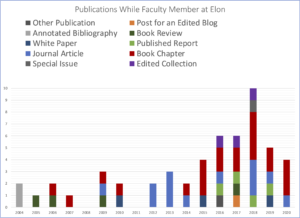Earlier this month, I was recognized with Elon University’s 2020-2021 Distinguished Scholar Award. Thank you to the Elon colleagues who nominated me, the Elon and disciplinary colleagues who wrote letters of support, and the review committee. Elon has many exceptional scholars, so I feel honored to be recognized and to join the ranks ofthese outstanding, previous honorees.
When I interviewed at Elon in 2004, the campus culture seemed almost too good to be true. Was this really a campus that centered engaged learning? Where faculty could pursue scholarship of teaching and learning (SoTL) alongside other forms of scholarship — and have its value recognized in annual reviews, tenure, and promotion?
I won’t pretend that the journey has been entirely rosy, but I appreciate that Elon steadfastly celebrates not only engaged learning, but also the study of engaged learning — and that SoTL informs my and colleagues’ scholarly teaching. I believe that my selection for the Distinguished Scholar Award reaffirms that commitment.
As I reflect on my scholarly activity and think about how junior colleagues might read the quantification of that activity, though, I also want to be transparent about the ebbs and flows in my productivity. As the chart below illustrates, I’ve had gaps in my publication record, and the genres I’ve prioritized have changed over time. To reflect the range of genres I write, I included a few examples (e.g., white papers, published reports, a post for an organization’s edited blog) that I don’t include in counts of my peer-reviewed scholarship, but that have been cited by others (sometimes quite frequently, as with the Elon Statements) or that serve as records of other professional activity.

Any visual representation of scholarly productivity will have limitations. For instance, this representation equally weights all publication types, even though some (e.g., edited collections) reflect much more time and sustained effort than others, so keep in mind that my annual reviews and applications for promotion always have included descriptive narratives about my scholarship.
This representation also doesn’t include the many multimedia texts I’ve composed for the Center for Engaged Learning or my work as a series editor for two book series — texts that contribute both to research on and teaching in support of engaged learning.
Yet the chart highlights:
- 2 gaps in my publications — 1 pre-tenure and 1 post-tenure. Although I always had something in progress, I couldn’t control production/publication schedules. I’ve had some publications linger in post-acceptance production schedules for up to 2 years. In addition, I’ve had a few projects wither away without being published — for a variety of reasons. I’d be happy to share my “flops,” but my main point in sharing that they exist is to acknowledge that a steady and consistent research agenda often isn’t comprehensively represented by publication outputs.
- White papers that previewed peer-reviewed publications. This strategy isn’t without controversy and challenges, but the Revisualizing Composition white paper and the Elon Statement on Writing Transfer offer two examples of collaborative teams sharing snapshots of findings — resulting in citations — before our finer-grained articles or chapters made it through peer review and production for publication. The Elon Statement on Writing Transfer, for instance, was first released in 2013, with a modest update published to the Center for Engaged Learning’s website in 2015. The edited collections featuring research that informed that statement weren’t published until 2016 and 2017.
- An increase in scholarly production over time. As a graduate student, I had the opportunity to collaborate on annotated bibliographies for the Journal of Second Language Writing, which helped me develop habits for reading current scholarship and writing regularly. Yet it still took me a while when I transitioned to a full-time faculty position with an increased teaching load and service expectations to find a new rhythm for research and writing.
What the chart doesn’t illustrate is that:
- My research agenda often is tightly woven with my teaching and service. Serving on my campus’s service-learning advisory committee, teaching a service-learning class, and conducting a SoTL inquiry about the associated learning outcomes were mutually informing and beneficial activities, reflected in two of my publications. Similarly, I’ve tried to build opportunities for “going public” into all of CEL’s multi-institutional SoTL projects, and I look for the potential for scholarly activity in many of my service commitments. As a result, I’m not trying to “find” (as much) time for my research because it’s embedded in much of my other work activity (though I admittedly still have to preserve time for writing).
- Many of my publications are co-authored. I’ve had the pleasure of working with several research teams, and when everyone is committed to both the project and the team, members can take turns moving projects forward. In some collaborations, that teamwork and sense of community also has led to more publications as different members have been able to take the lead on different swaths of data concurrently.
I hope that sharing my reflection on my scholarly activity might offer others some adaptable strategies for their own scholarship journeys. While I’m honored by the Distinguished Scholar designation, I’d be remiss not to thank my many collaborators and my writing group. I’m grateful to have worked with so many other exceptional scholars and look forward to continued collaborations.